
19 Solutions for Magento 2 Export Products Not Working Issues
Are you having trouble with Magento 2 export products not working? This issue can disrupt product management, especially when exporting product data to CSV files.
This tutorial will cover the causes and solutions for resolving the 'Magento 2 export products not working' issues.
Key Takeaways
- Common causes and fixes for export issues that cause delays & disrupt your workflow.
- Troubleshooting tips for the export product CSV file issue for various expertise levels.
- Problems and solutions linked to configuration settings, cron jobs, or file permissions.
- Methods to resolve most export-related issues.
- Prevention strategies to ensure cron jobs are running and verify file permissions.
- Advanced export features to use Magento extensions.
-
19 Common Causes and Solutions for Magento 2 Export Product Stack Not Working
-
Prerequisites for Fixing Exported CSV Not Appearing in Adobe Commerce on Cloud Infrastructure
-
3 Methods for Solving Product Export CSV File Does Not Appear in Magento2
-
3 Steps to Resolve Magento 2 Export Product CSV File Permission Issues
19 Common Causes and Solutions for Magento 2 Export Product Stack Not Working
1. Memory Limit Issues
Magento 2 requires sufficient server resources to export product data. The process can time out or fail if your PHP memory limits are set too low.
To solve this, increase your server’s PHP memory and execution time limits by modifying the php.ini file. For example, you can:
- Set
memory_limitto at least "2G". - Increase
max_execution_timeto "1800". - Adjust
max_input_timeto match the execution time.
This configuration ensures Magento has enough resources to handle larger product catalogs.
2. Permission and File System Errors
The export will fail if the file or folder Magento is trying to write does not have the correct permissions.
To fix this issue, follow these steps:
i. Check the permissions of your Magento export directories.
ii. Ensure they are set to writable, particularly the /var/export/ directory.
iii. Use the following command:
chmod 775 /var/export/
This method will ensure that Magento can write the exported file.
3. Database Connection Problems
Network issues or database configuration problems can cause a disconnect. It happens when Magento attempts to fetch data. Admins need a smooth connection to their store's database to pull the product data for export. If the connection is faulty, the export might fail.
To solve this issue, you can:
- Test the database connection to ensure it's stable.
- Review your database logs for any errors.
The export process may hang or fail if your database connection is unstable.
4. Export Grid Configuration Issues
Wrong settings in the grid configuration can cause Magento to be unaware of what needs to be exported. Magento might not know what data to export if your grid configuration isn’t set up correctly. Or it may create an incomplete export file.
To fix this issue, follow the steps below:
i. Go to Admin > System > Data Transfer > Export.
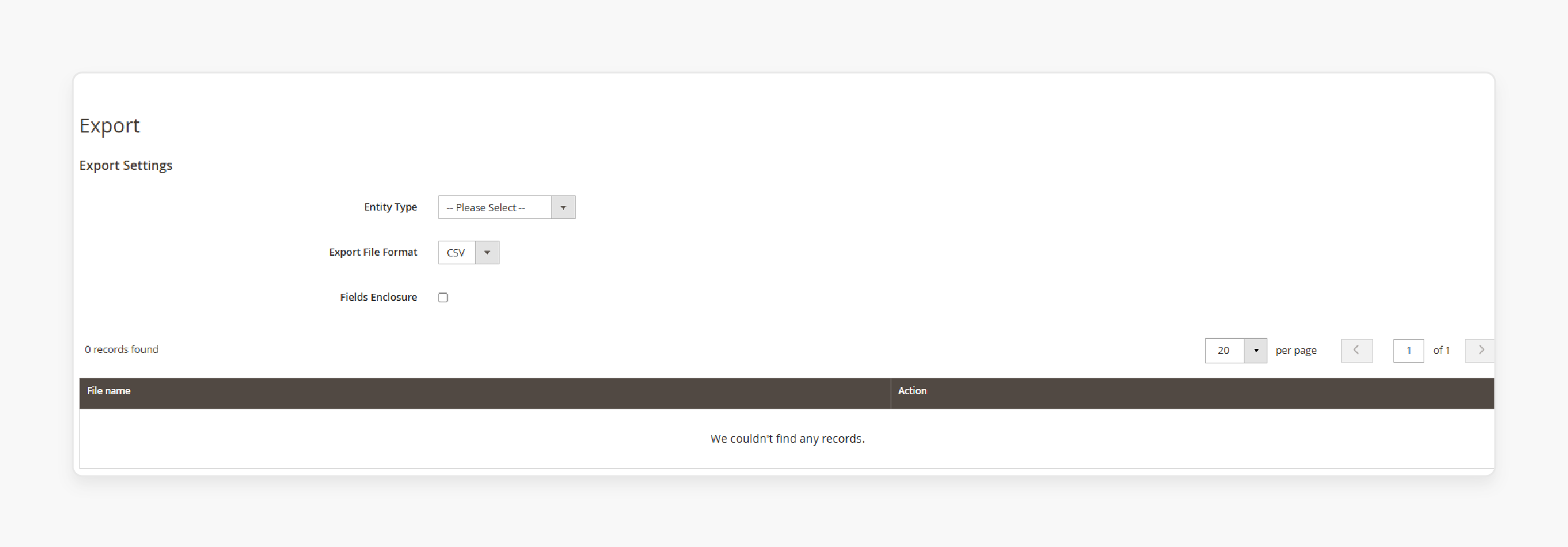
ii. Make sure the correct entity type (Products) is selected.
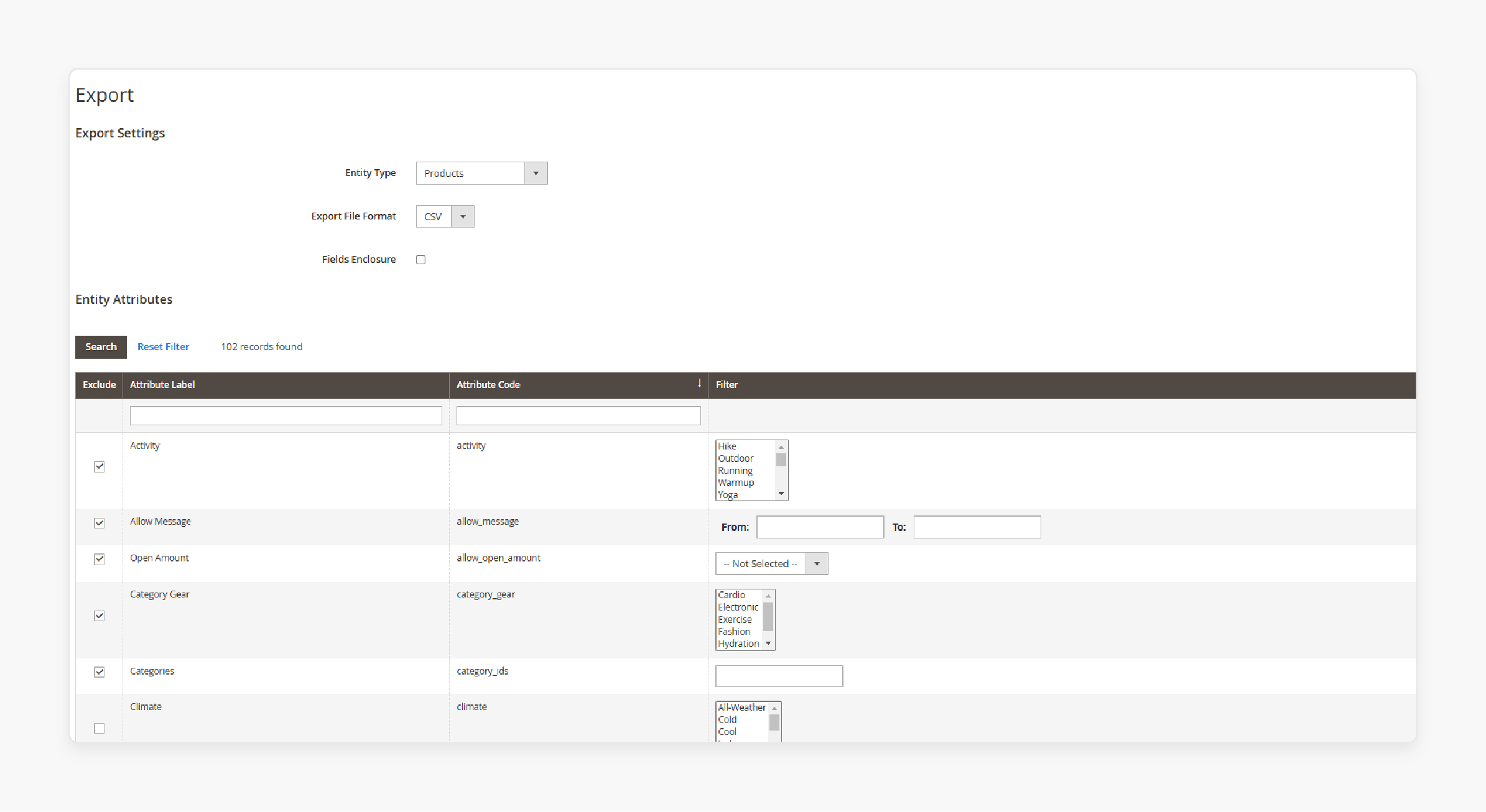
iii. Ensure all required fields like "product name", "SKU", "price", and "stock status" are selected for export. iv. Choose CSV as the file format.
5. Incorrect File Permissions
The export will fail if Magento can't access or modify the export file due to restricted permissions.
To solve this problem, follow these steps:
i. Ensure the export directory and file have proper permissions. ii. Use the following syntax to adjust file permissions:
chmod 644 /var/export/filename.csv
This process allows Magento to read, write, and execute the file.
6. Cron Job Errors
Cron jobs automate repetitive tasks without manual intervention. If they're disabled or misconfigured, exports will fail to run automatically. Magento relies on cron jobs to handle regular tasks, including exports. If your cron jobs aren’t running, your exports won’t either.
To resolve this issue, check the steps below:
i. Check that your cron jobs are running. ii. Run the following command:
php bin/magento cron:run
iii. Ensure cron jobs are enabled in Admin > Stores > Configuration > Advanced > System. iv. Review the cron execution log to identify any failures or issues.
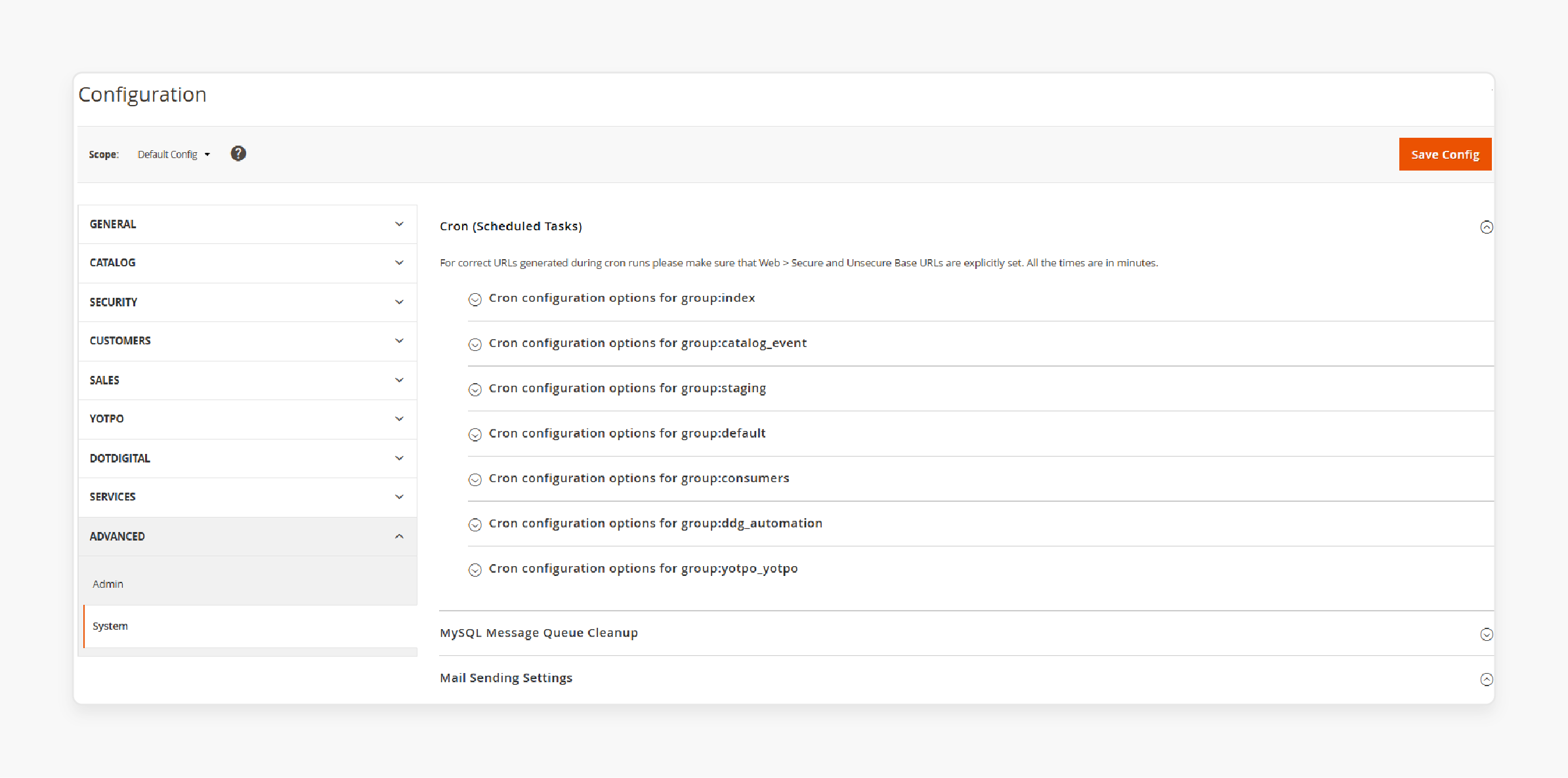
7. Security or Configuration Issues
Magento's security settings can block export attempts due to security settings/conflicting configurations. It mainly occurs if you have restrictive rules in place.
To solve this issue, follow the steps below:
- Disable any security rules that could block file creation.
- Double-check API tokens if using REST API for export.
- Review your server’s firewall and security settings.
- Enable admin user permissions.
- Make sure Magento can write to the export directory.
- Configure the SSL certificate status.
8. Bugs in Magento 2 Version
Magento 2, like any software, occasionally has bugs. They affect core features like exporting products. Sometimes, the problem lies with a bug in the Magento 2 version you’re using. These bugs might prevent exports from completing successfully.
Consider the following practices:
- Make sure you're using the latest stable version of Magento 2.
- Check Magento’s bug tracker for any known issues related to exports.
- Update your Magento installation to fix any bugs that may be causing the issue.
9. Incorrect Configuration Settings
Magento may not be exporting the data because of incorrect settings. It might also happen due to missing fields in your export configuration.
Consider these practices:
- Ensure the right profile is selected for export. Without the correct profile, Magento won't export the data as expected.
- Make sure you're exporting data in the correct format (e.g., CSV). Other formats may cause issues.
10. Third-Party Export Extensions
If you're using third-party tools, they may interfere with the native export process. Check if these tools are configured properly or if they need updates. In cases where automated exports fail, consider manually exporting products. Use the built-in CSV export functionality to ensure smooth operation.
If the built-in export functionality is unreliable, consider using third-party extensions. These extensions offer enhanced features & better error handling for product exports by providing:
- Improved export speed
- Advanced filtering options
- Enhanced error reporting
- Custom export mappings
- Error handling capabilities
- Support for complex product types
11. API-Based Export Methods via CSV
If the default export method fails, API-based export might be an alternative. Ensure that your API settings are correct and the required endpoints are accessible. When automated methods fail, you can manually trigger the export process via the backend. It helps isolate issues related to the export mechanism itself.
12. Specific Fixes Based on Error Messages
Magento 2 often provides detailed error messages when the export fails. Analyzing and acting on these messages helps you resolve issues more effectively. A best practice is always to check the logs for detailed error info.
13. Queue Consumer Issues
Export failures trace back to message queue consumers not running properly. Ensure the exportProcessor consumers are active. The two key consumers for export functionality are:
- magento.catalog.export.consumer magento.export.consumer
To check consumer status, run the following command:
bash bin/magento queue:consumers:list
14. File System Roadblocks
Magento 2 needs specific file system permissions to create & write CSV export files.
Consider these practices:
- Ensure the
var/exportdirectory has "775 permissions". - Verify proper ownership (usually www-data:www-data).
- Check that there is enough disk space available for exports.
15. Database Connection Timeouts
Large exports may strain your database connection. To avoid connection timeouts, follow these practices:
- Increase the
MySQL wait_timeoutvalue. - Optimize database indexes.
- Consider table partitioning for large catalogs.
16. Export Profile Configuration
Incorrect export profile settings can prevent successful exports. Ensure the following practices:
- Correct attribute set mappings.
- Check proper field enclosure settings (leave unchecked unless necessary).
- Verify category path configuration.
- Ensure custom attributes are included in the export.
17. Cron Job Dependencies
Export processes heavily depend on cron jobs running at the correct intervals. If cron jobs aren't configured correctly, exports can fail. Ensure these practices:
- Set up a dedicated cron for export tasks.
- Ensure proper cron scheduling intervals.
- Monitor cron execution logs for errors.
18. Version-Specific Bugs
Certain Magento 2 versions have known export-related bugs. For instance:
- 2.3.5-p1 has export grid issues.
- 2.4.x versions require specific security patches to avoid export failures.
- Adobe Commerce's cloud infrastructure has specific configurations for export tasks.
Ensure your version is patched and up to date to prevent bugs from affecting exports.
19. Clear Cache and Reindex
Outdated cache or incomplete index files may block exports. Follow the steps below:
i. Go to System > Cache Management. ii. Flush the Magento cache. iii. Run the following commands via SSH:
php bin/magento indexer:reindex
php bin/magento cache:clean
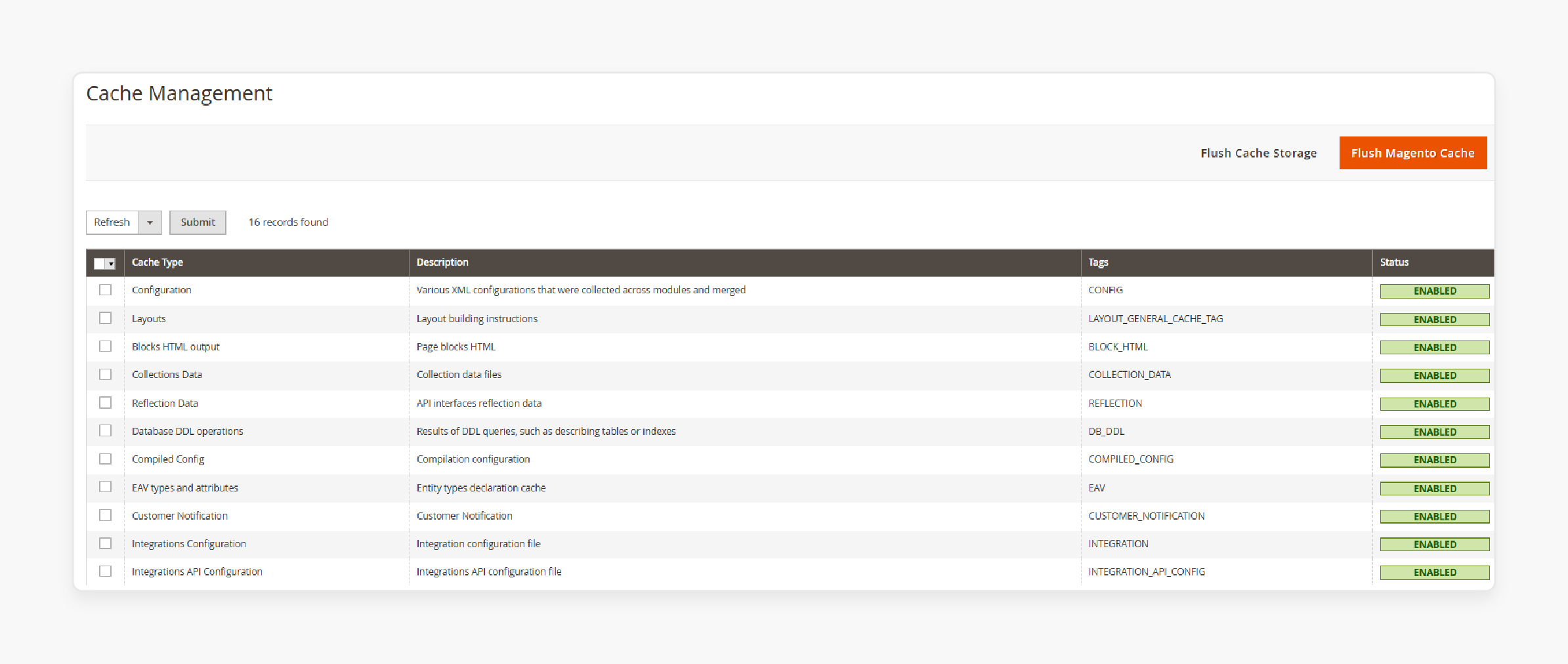
Best Practices for Preventing File Manager Issues
| Practice Area | Advanced Strategies | Business Impact |
|---|---|---|
| Version Control | - Git integration for export templates - Change tracking for export profiles - Rollback points for configurations |
Maintains export consistency across updates |
| Automated Monitoring | - Export success rate tracking - Performance metrics collection - Automated alert systems |
Early detection of potential issues |
| Load Distribution | - Time-based export scheduling - Server load balancing - Peak-hour avoidance |
Optimizes server resource usage |
| Data Validation | - Custom validation scripts - Automated data quality checks - Error pattern analysis |
Ensures data integrity |
| Recovery Automation | - Self-healing scripts - Automatic retry mechanisms - Failover procedures |
Minimizes manual intervention |
| Documentation | - Export configuration versioning - Change log maintenance - Process documentation |
Facilitates troubleshooting |
| Integration Testing | - API endpoint monitoring - Third-party integration checks - Compatibility testing |
Prevents integration-related failures |
| Resource Scaling | - Dynamic resource allocation - Cloud storage integration - CDN implementation |
Handles growing catalog sizes |
Prerequisites for Fixing Exported CSV Not Appearing in Adobe Commerce on Cloud Infrastructure
- Go to Stores > Configuration > Advanced > Admin > Security in the Commerce Admin.
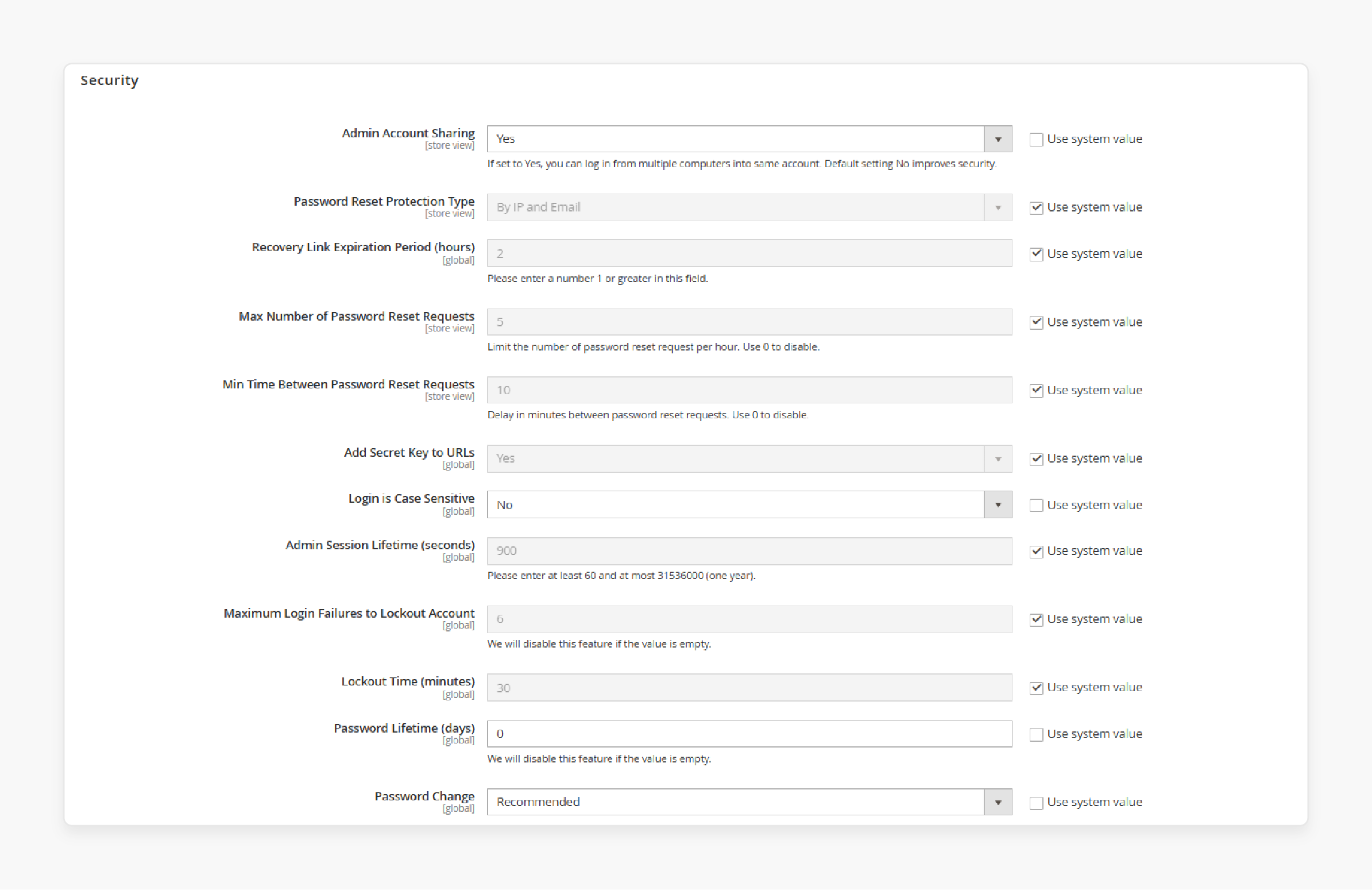
- Ensure the 'Add Secret Key to URLs' option is set to "Yes."

- Navigate to System > Data Transfer > Export in the Admin panel.
- Select:
- Entity Type: Products
- Export File Format: CSV
- Field Enclosure: Leave unchecked.
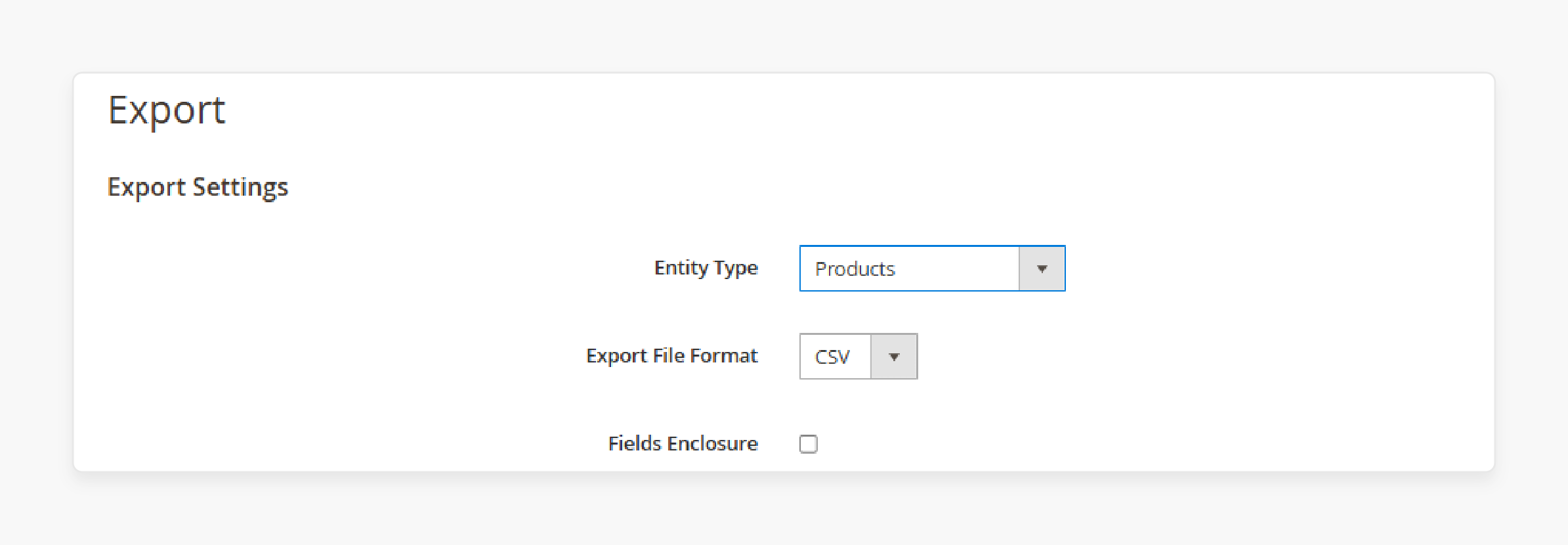
- Click 'Continue'.
Note: The message "Message is added to queue, wait to get your file soon" appears.
3 Methods for Solving Product Export CSV File Does Not Appear in Magento2
Method 1: Disable the 'Add Secret Key to URL' Option
- Go to Stores > Configuration > Advanced > Admin > Security in the admin panel.
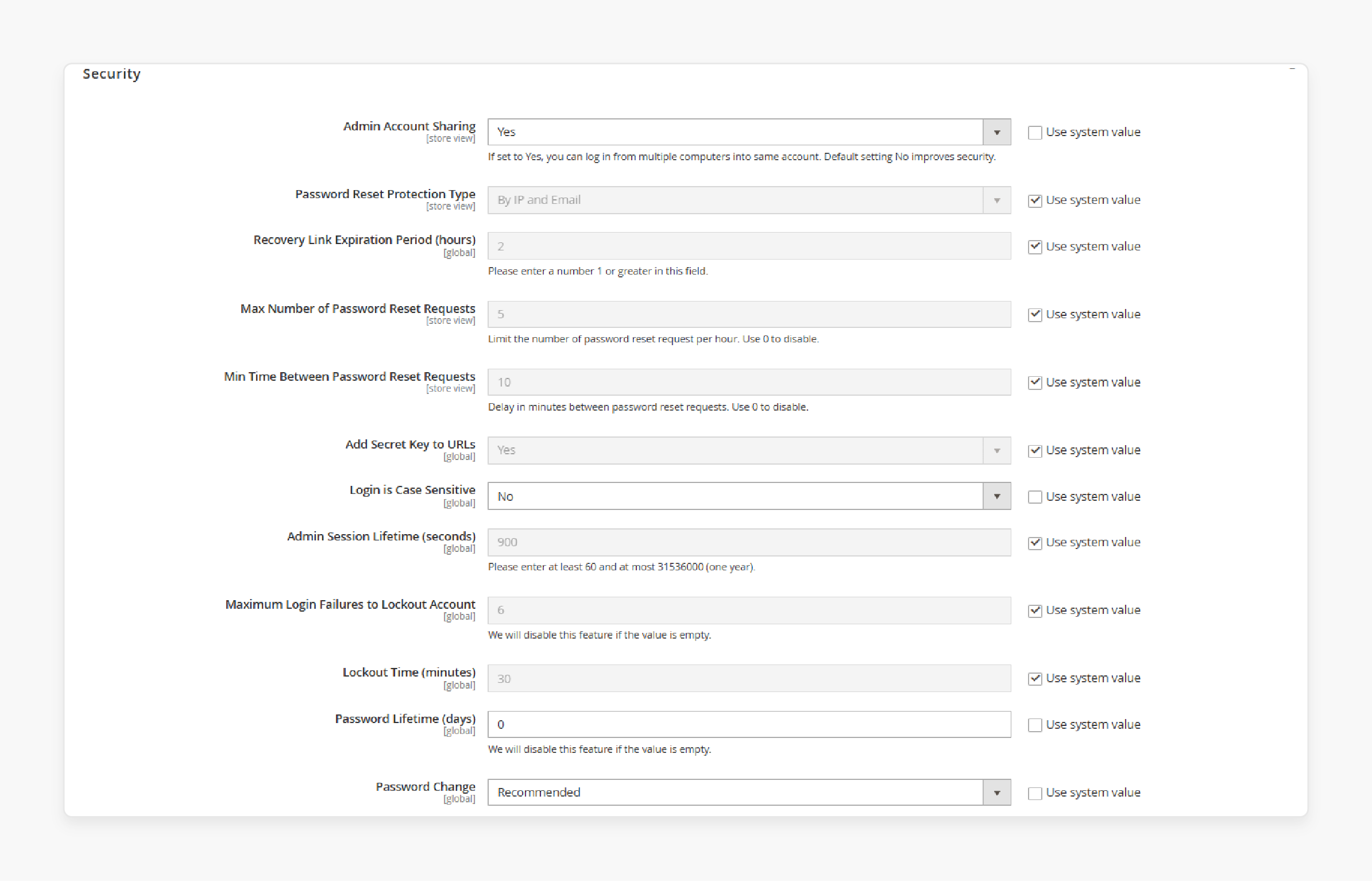
- Set the 'Add Secret Key to URLs' option to "No".

- Click on the 'Save Config' button.
- Clear the cache under System > Tools > Cache Management, or run the following command:
bash bin/magento cache:clean
- Alternatively, clear the cache from the admin panel.
Method 2: Run the Export Command Manually and Optionally Configure it as a Cron Job
- To generate the export file, run the following command:
bin/magento queue:consumers:start exportProcessor
- Once run, the export file should appear in the grid.
Note: Add the CRON_CONSUMERS variable to the .magento.env.yaml file to configure this process to run automatically as a cron job.
Method 3: Add Cron Job (Optional)
- Ensure your cron jobs are correctly set up.
For more information, refer to the Cron Jobs Set Up guide.
- Run the following command to list the message queue consumers:
./bin/magento queue:consumers:list
- Navigate to the
.magento.env.yamlfile located in the root application directory. - Add the required consumers, such as the exportProcessor command.
- Push the updated file and redeploy your environment.
- For further details, refer to the [Custom Cron Jobs] section.
Note:
If the .magento.env.yaml file is missing or deleted from your environment, you must create a new one. Initially, it may be empty, but you can add the necessary configurations. For more information, refer to the Configure environment variables for deployment & Environment variables.
YAML files are case-sensitive and do not support tabs. Improper formatting may cause issues. So, ensure consistent indentation throughout the .magento.env.yaml file. You can use the ece-tools validate command to check your configuration.
Advanced Fixes for Magento 2 Product Export and Import
| Issue Type | Solution | Expected Result |
|---|---|---|
| Command Line Export | Use CLI commands for direct export. | Bypasses admin interface issues |
| Memory Limits | Increase PHP memory allocation. | Handles large product catalogs |
| Queue Processing | Enable message queue consumers. | Ensures export processor functions |
| File Permissions | Adjust directory permissions. | Allows proper file creation |
| Database Connection | Optimize MySQL settings. | Prevents timeout during large exports |
| Export Profile | Configure export settings. | Ensures correct field mapping |
| Cron Jobs | Verify cron execution. | Maintains scheduled exports |
| Module Conflicts | Disable conflicting extensions. | Eliminates interference |
| Server Resources | Optimize server configuration. | Prevents timeout issues |
| Export Format | Validate CSV structure. | Prevents data corruption |
3 Steps to Resolve Magento 2 Export Product CSV File Permission Issues
- Create a
di.xmlfile in the following directory:
app/code/Vendor/Extension/etc/adminhtml/di.xml
- Create the preference file at the path below:
app/code/Vendor/Extension/Controller/Adminhtml/Export/File/Download.php
- Run the following commands to complete the process:
php bin/magento setup:di:compile
php bin/magento cache:flush
CSV Export Solutions: Alternative Spreadsheet Options
| Solution Type | Features | Best For | Limitations |
|---|---|---|---|
| Google Sheets | - Direct CSV generation - Real-time collaboration - Automatic UTF-8 encoding - Version history tracking |
- Small to medium catalogs - Team collaboration - Quick edits |
- File size limits - No direct Magento integration |
| LibreOffice Calc | - Advanced formula support - Excel compatibility - Custom CSV encoding - Macro functionality |
- Large datasets - Complex calculations - Custom export formats |
- Manual export process - Local installation required |
| Zoho Sheet | - AI-powered data cleaning - Real-time collaboration - Excel file compatibility - Custom validation rules |
- Data cleaning needs - Multiple-user access - Automated workflows |
- Premium features require a subscription - Learning curve for advanced features |
| Excel Power Query | - Advanced data transformation - Custom data filtering - Automated refreshing - Multiple data sources |
- Complex data manipulation - Regular updates - Large catalogs |
- Requires Microsoft 365 - Windows-only features |
| API Integration | - Direct database access - Custom field mapping - Automated exports - Real-time updates |
- High-volume exports - Custom integration needs - Automated workflows |
- Technical expertise required - Development overhead |
| Third-party Extensions | - Dedicated Magento support - Multiple format support - Scheduled exports - Error handling |
Regular exports - Complex product data - Multi-store setups |
- Additional cost - Platform dependencies |
FAQs
1. Why does my attempt to export products fail?
If you try to export products but fail, it could be due to server issues, incorrect configuration, or export profile settings. Check your product export CSV file manager for any discrepancies. Also, confirm that the cron jobs are running and verify your database connection.
2. How can I fix a stack overflow error during export?
A stack overflow error during export usually occurs when memory limits are exceeded. To fix the issue, increase the PHP memory limit in your hosting environment. You can also adjust the memory limit in your php.ini file.
3. What privacy considerations exist during product export?
Review export data policies, protect sensitive information, and limit exported data. Also, configure user permissions, validate data protection settings, and follow compliance regulations.
4. How can I display the exported products in my grid?
Verify the file format and check the permissions on the /var/export/ directory. Then, review the export profile settings. Also, confirm that cron jobs are running to trigger exports.
5. How do I install third-party tools for product export?
To install third-party export tools, download the extension or app. Then, log in to Magento Admin and navigate to System > Web Setup Wizard. Select "Install" and follow the on-screen instructions. Refer to the extension's installation guide to ensure correct installation without skipping steps.
6. What do I need to do before adding consumers to the queue?
Before you add consumers to the queue, verify your system's configuration. Include the consumers you would like in your magento.env.yaml file. Then, apply the changes and deploy the new configuration. Cron jobs must be properly set up to allow consumers to execute successfully.
7. How can I effectively manage product export sample rows in Magento?
When configuring export options, review sample rows carefully to check reference data. Then, verify each row's configuration by selecting the appropriate column. Finally, validate data integrity after version updates and use CPanel for advanced management.
Summary
The 'Magento 2 export products not working' problem can affect your ability to download product information. Fixing this issue allows store admins to:
- Ensure proper file permissions to avoid export file errors.
- Simplify and facilitate product exports.
- Manage their Magento store for enhanced functionality.
- Ensure that the correct fields are selected for the export.
- Maintain configuration settings and cron jobs.
- Export product data at set intervals to manage large product catalogs more efficiently.
Ensure smooth product exports with Magento hosting services.



